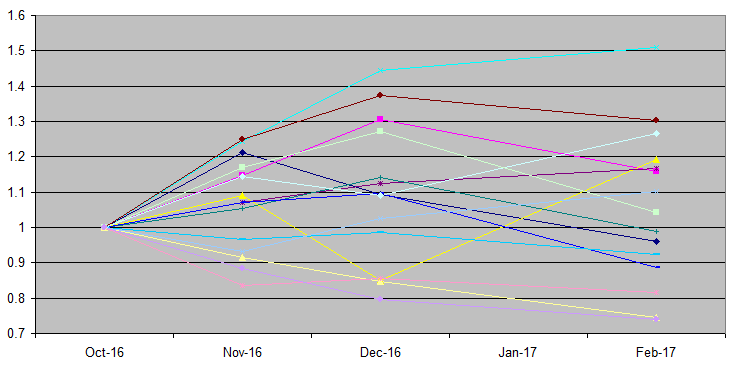- Joined
- Oct 13, 2010
- Messages
- 10,735
For what it's worth, I'm going to attempt to document how the Joel Goldblatt magic formula does against some benchmarks. The first result will be computed in December of 2019 (that's how long he says you need to wait for it to work).
The idea will be for me to pick six dates, about 2 months apart where I "execute trades". So there will be six groups. The first six of these dates will be buys only, where 1/6th of the eventual seed money will be invested evenly over that month's picks. For the rest of these dates, I will document sells from the prior year and document the new buys. The dates will only be approximately 2 months apart.
If a randomly selected stock is already owned (in any except the current group), it will be skipped, and the next randomly selected stock will be substituted. If a randomly selected stock is already owned and in the current group (to be sold), it will not be sold (be kept for another year).
On each of the buy/sell days, I will document what my random selection of that day's magic formula stocks came up to be, and their prices.
I'll also try to keep track of dividends, splits, buyouts, etc. Not sure how good I'll be at documenting that, but I'll give it a try.
Ticker|Executed price |Execution date |
CRSPSCVT|1653.38|06/23/2016 14:15|Benchmark
VBR|106.68|06/23/2016 14:15|Benchmark
BKE|25.76|06/23/2016 14:15|June 2016 Pick
HSII|17.66|06/23/2016 14:15|June 2016 Pick
INSY|12.92|06/23/2016 14:15|June 2016 Pick
KFY|22.57|06/23/2016 14:15|June 2016 Pick
MSGN|16.81|06/23/2016 14:15|June 2016 Pick
STRA|48.22|06/23/2016 14:15|June 2016 Pick
See you in a few months!
The idea will be for me to pick six dates, about 2 months apart where I "execute trades". So there will be six groups. The first six of these dates will be buys only, where 1/6th of the eventual seed money will be invested evenly over that month's picks. For the rest of these dates, I will document sells from the prior year and document the new buys. The dates will only be approximately 2 months apart.
If a randomly selected stock is already owned (in any except the current group), it will be skipped, and the next randomly selected stock will be substituted. If a randomly selected stock is already owned and in the current group (to be sold), it will not be sold (be kept for another year).
On each of the buy/sell days, I will document what my random selection of that day's magic formula stocks came up to be, and their prices.
I'll also try to keep track of dividends, splits, buyouts, etc. Not sure how good I'll be at documenting that, but I'll give it a try.
CRSPSCVT|1653.38|06/23/2016 14:15|Benchmark
VBR|106.68|06/23/2016 14:15|Benchmark
BKE|25.76|06/23/2016 14:15|June 2016 Pick
HSII|17.66|06/23/2016 14:15|June 2016 Pick
INSY|12.92|06/23/2016 14:15|June 2016 Pick
KFY|22.57|06/23/2016 14:15|June 2016 Pick
MSGN|16.81|06/23/2016 14:15|June 2016 Pick
STRA|48.22|06/23/2016 14:15|June 2016 Pick
See you in a few months!


